The Irish avoided another home game with late drama against a MAC opponent despite a dreadful start. This was a game that looks far better on the spreadsheet than in real life, creating terrific conditions for a lot of debate. Is Riley Leonard tanking the offense, and it should be Steve Angeli time? But what would happen without Leonard’s legs? Is the defensive dominance on third downs and in the red zone the signs of an elite unit? Or are some of the easy yards given up, especially on the ground, red flags for what more talented offenses may do?
Despite the gross start, this was a decisive win by all the metrics and the Irish now sit at 10th in F+ ratings as preseason projections continue to phase out. As forecasted, the defense is creeping up from 10th in the preseason toward becoming a top-5 unit (7th in Defensive F+), and the offense is sliding a bit from 10th in preseason projections to the 20-30 range (21st in F+).
Garbage time in this game began after Riley Leonard’s 50-yard touchdown to make it 28-3 in the 4th quarter, so just 11 plays were excluded from the numbers below.
Watch this game backwards, Tenet style?

While things were bleak early, the final box score is pretty clean sheet for the Irish. Marcus Freeman’s team finished +17% in success rate, +3.5 yards per play, and crushed the Redhawks in taking advantage of scoring opportunities (5.6 points per scoring opportunity vs 0.75). Notre Dame was also unlucky in the turnover battle, recovering zero fumbles of the four to hit the turf and picking off two passes out of 10(!) pass break ups. The Irish were expected by the numbers to win the turnover battle (3.2 expected for Miami, 1.2 for ND) but instead it was a draw (with an added botched field goal attempt for good measure).

If you could engineer a way to watch this game backward, it feels like the fan approval ratings for both Riley Leonard and this game overall go up a good 25%. The ending wouldn’t be fun, and maybe lead to some questions about Leonard yips and taking the foot off the gas, but the long touchdowns and deep passes would have eased a lot of early tensions.
As it actually took place, yikes it was an incredibly bad first quarter. The Irish barely had the ball, shot themselves in the foot twice on special teams, and were downs 30% in success rate without a first down conversion. Still, despite that gloominess, by halftime the numbers battle had already swung dramatically in Notre Dame’s favor (Efficiency: 54% ND vs 36% MIA; YPP: 6.8 ND, 4.3 MIA).
Diving into the Riley Leonard take-pocalypse
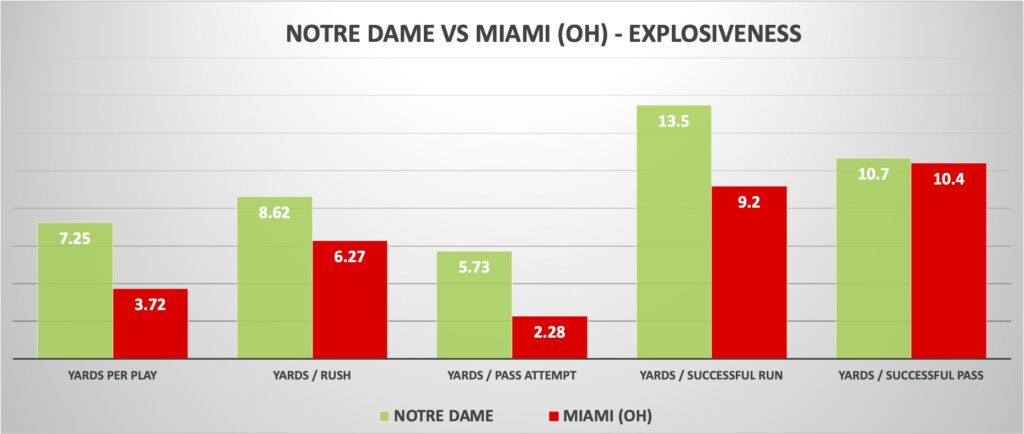
Speaking of the rough start, the million dollar question is what exactly is causing Leonard’s struggles with easy lay-up throws and accuracy. There’s plausible physical and mental explanations, but the inconsistency between plays and drives makes things more mysterious. At Duke, Leonard’s adjusted completion percentage (excluding drops) on medium throws was ~58% in 2022 and 2023. In a Notre Dame uniform, that number is 46% – is there a physical problem driving this, does he have the yips, or can we expect some positive regression?
Against Miami, Mike Denbrock and Leonard at least finally put some deep passing attempts out there for opponents to respect. This was by far the most long attempts with the long TD to Beaux Collins, three others that drew pass interference calls, and a missed end zone shot to Jayden Harrison. Despite this bump (and the stats will miss the DPI plays), through four games Leonard’s deep ball (20+ yards downfield) percentage sits at a career low 6.7% of attempts (in 2022-23 at Duke it hovered between 12-13% of attempts).
PFF’s elusiveness score looks at how well rushers gain yards after contact, force missed tackles, and create breakaway runs.
FBS rushers with >25 attempts:
1. Jeremiyah Love
2. Jonah Coleman
3. Terion Stewart
4. Ashton Jeanty
5. Riley Leonard (#1 among QBs)(JD Price is 31st)
— Michael Bryan (@michaelbryanMB) September 23, 2024
Leonard’s legs also feel undervalued at the moment. On 47 carries, his numbers on the ground are staggering – 8.23 yards / carry (1st among P4 QBs), 60.5% success rate, 4.7% stuff rate, and averaging 4.76 yards after contact (2nd P4 QBs). The threat of his legs is essential to the early season breakouts of Love and Price and to the offensive line that is holding up week to week despite the loss of three starters from the beginning of fall camp.
Still, there’s a lot of folks who have declared themselves out on Leonard, and the default fan reaction to shaky offensive struggles is to demand change and bench Leonard for Angeli. There’s an assumption built into that theory that Angeli’s passing is a significant advantage and the benefits from it will exceed the hit to the rushing attack. Are we sure that’s true? We really have no evidence to go off of in 2024, except that a staff that knows this is a critical year appears to be far less tempted by this value proposition than fans.
Opting out of this offensive approach could easily put the Irish offense in a world where the ND offense is even worse and not good at anything. Angeli at QB shrinks the rushing lanes for Love and Price. And while he may hit more lay up and downfield throws, Angeli has also flashed a tendency to take sacks and could easily be worse than Leonard putting the ball at risk. The wide receiver room hasn’t answered many question marks – are we sure they are getting open against defenses that are now more focused on defending the pass? We have a big sample size of Leonard avoiding turnover-worthy plays, despite the horrors of NIU, including just four passes defended by Irish opponents across Texas A&M, Purdue, and Miami.
From a program management perspective, does Angeli meaningfully boost the ceiling? I think you’d need to know the rushing attack can stay close to 75% as strong to even make that argument. There’s a world where Angeli struggles mightily behind this inconsistent offensive line, the rushing explosives dry up, the offense is worse and the Irish drop a few more games. It’s a worst case scenario for the ’24-’25 offseason, with Angeli not appearing to be a long-term solution and setting up a murky spring to see if he can improve enough to beat out an untested Minchey and Carr.
Finding QB play that can succeed at a high level and without ideal conditions is hard. What percentage of fanbases love their starting QB now or for the future? The transfer portal has probably entitled us as fans to even more of a mercenary mindset. But the growing obsession with recruiting and developing QB talent feels pretty silly in a season where many of the biggest title favorites like Ohio State, Oregon, and Texas all start transfers. We also see the other side of that coin where programs like Michigan and Auburn (likely the runner-up for Leonard) wish they had rolled the dice on even a lower-tier transfer like Diego Pavia, Eli Holstein, or Jayden Maiava.
A classic bend but don’t break performance that may be the 2024 identity
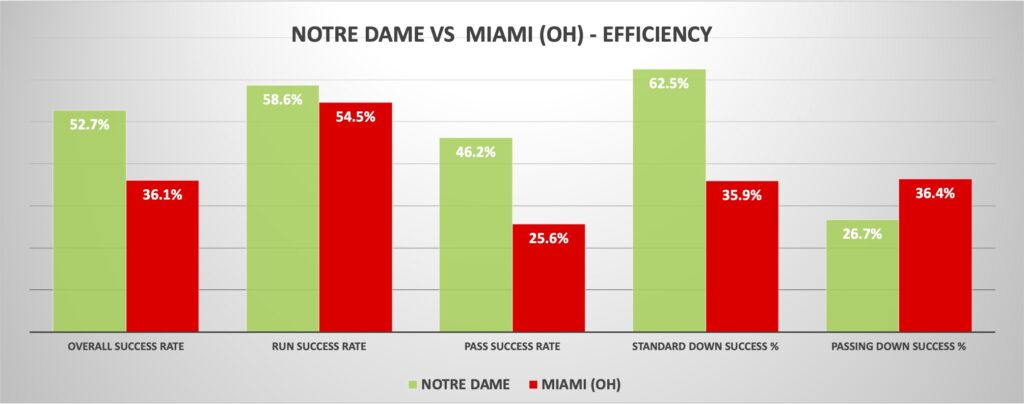
One third of the way through 2024 it’s interesting to look at Notre Dame’s defensive profile. The Irish haven’t faced an elite passing attack (or really a strong offense in general – A&M is a generous 30th in Offensive F+). But they rank 2nd in passing EPA per play and 9th in points allowed per drive, with some elite performance limiting scoring chances (9th in points per scoring opportunity). The Notre Dame defense limits explosives (top 10 in both long passing and rushing plays allowed per game) but will give you some smaller gains, especially on early downs (101st in average 3rd down distance for opponents).
G5+ EPA / play performance in the red zone pic.twitter.com/yV5U5ZqnQi
— Quinn MacLean (@QuinnsWisdom) September 24, 2024
Bend but don’t break seems like a strange characterization given how often Al Golden has opted to bring pressure, especially on passing downs. But that’s enabled by a trust in the back end of his defense and has paid off with opponent converting just 24.5% of 3rd down attempts (10th in FBS). Against Miami, we again saw the Irish defense take away an opponents preferred strength (passing) and maybe yield more than ideal on the ground against a bad rushing offense (6.27 yards / carry and a 55% success rate for a Redhawk offense that entered virtually dead last in FBS).
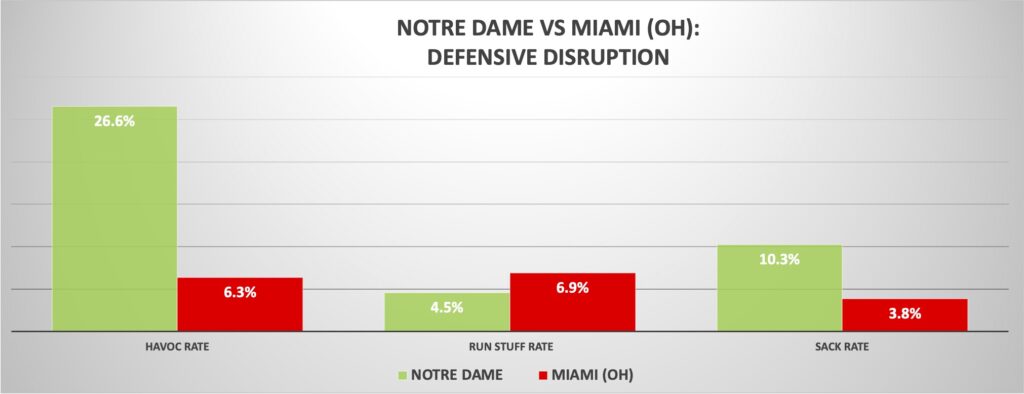 Is the softness against the run a strategic play or are there real concerns there? The NIU performance suggests it’s worth continuing to monitor, as Notre Dame now ranks 107th in rushing success rate allowed (vs. 3rd against the pass). It’s early and not time to panic – UGA profiles similarly at #95 in run defense efficiency but #9 vs the pass, and I don’t think many analysts are sweating about their defense. But against more talented opponents like Louisville, we need to see the Cardinals dangerous passing attack held in check to offset any success given up on the ground. Notre Dame can win bending but not breaking, but if Brohm can scheme up some long drives and an explosive play or two, the formula won’t hold up.
Is the softness against the run a strategic play or are there real concerns there? The NIU performance suggests it’s worth continuing to monitor, as Notre Dame now ranks 107th in rushing success rate allowed (vs. 3rd against the pass). It’s early and not time to panic – UGA profiles similarly at #95 in run defense efficiency but #9 vs the pass, and I don’t think many analysts are sweating about their defense. But against more talented opponents like Louisville, we need to see the Cardinals dangerous passing attack held in check to offset any success given up on the ground. Notre Dame can win bending but not breaking, but if Brohm can scheme up some long drives and an explosive play or two, the formula won’t hold up.



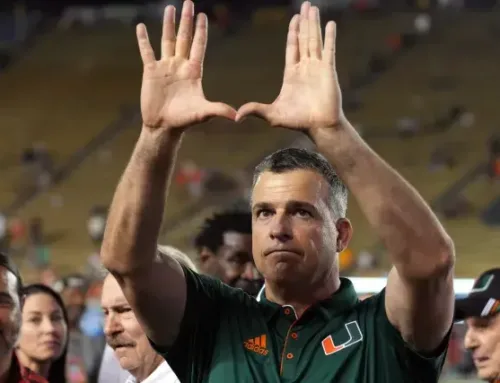
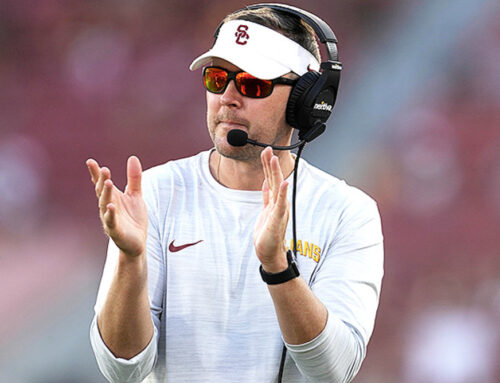
I really appreciate these articles! Very helpful in expanding how I take in the Irish action beyond the eye test.
Unrelated also but I’m hearing v good things about ND MBB recruiting right now
Michael,
These are lots of work for you, and really valuable and well done. They offer a nice corrective to our various eyeball tests. In this case, you may get some pushback, but I find your take on the value of Riley Leonard most valuable.
Merci!
Sounds like Mickey has decided to RS and transfer. Probably a sign that he would be in a serious competition with Moore to start next year. Will test that excellent pass defense depth.
Yea certainly a bummer for the depth this year. Thankfully Moore and Hobbs has gotten some pretty good action so far and have not been out of their element. But the talk was that Clarke or Heard could move to CB in a pinch (more Heard than Clarke I think only because Clarke has played so well at nickel).
I was discussing this game with my brother who quit watching somewhere around half. He was complaining about the teams performance (legit complaints I think). I kept thinking I bet the advanced stats will show this to be a better game than it felt like it was.
One thing I keep thinking about is how bad our O-Line might be, and how much the elusiveness mentioned above by Love and Leonard (and Price, to a degree) is bailing them out.
I do NOT want Angeli at this point, he took enough bad sacks at Purdue that I think he’ll get killed trying to be a pocket passer with this line. And I know Leonard is a great (elite?) runner. If we were just leaning into that 100% we wouldn’t have lost NIU, at least.
But I’m ready to see what the kids can do. It seems they are comfortable running with Minchey. I was one of the people in the Slack who quit watching right before the first TD drive when Leonard went back out. And putting in Angeli and having him do even an above average job does what for the program, exactly? If they pull Leonard I would rather they see what Minchey can actually do with the similar mix of QB run/short passes, but with a bit more passing and bit less running than Leonard.
I have a bad feeling we’re going to get our answer this Saturday. Either Leonard breaks 100 yards running and makes enough passes to see some progress, or he has another bad game, we lose, and the season’s done.
Either way, I don’t see any reason to see any more Steve Angeli this year.
Yea I don’t think Angeli is the answer either. Leonard probably still has the most upside with his running ability if he can hit more of those downfield throws.
With the younger QBs it’s hard for them to be ready to play when, presumably, they aren’t getting any snaps during the season to prepare.
Hot take: Riley Leonard will break George Gipp’s record of 8.1 yards/rush over the season. Take it to the bank!
Love and Price are both averaging 7.4 ypc right now, to Leonard’s 7.0, since officially sacks yds are rushing yds.
If Price maintains about half the carries of Love/Leonard, he’s probably the most likely to finish with the highest ypc of the 3. But if you took out sacks, 8.1 ypc would definitely be in play for Leonard.
lmao
i’m just gonna assume this is the curse breaker…unless and until reality makes me not.
Aww yeah baby time for the folks to get furiously pissed off after a win over a ranked team